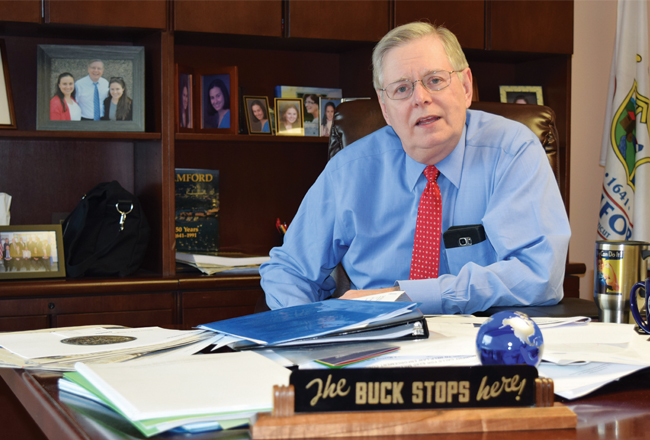Stamford Mayor Martin presents mostly sunny state-of-the-city address
Although he considers the city to be in a better position today than it was when he took office in 2013, Mayor David Martin said Stamford “continues to face challenges that require diligent focus from our city staff and commitment from our elected officials” at his annual state of the city address to Stamford”™s Board of Representatives on July 2.

On the plus side, the mayor said that more people, particularly younger ones, are choosing Stamford over other options in Fairfield County and the New York City region as places to live and work ”“ something he said was driven by its public safety efforts. Stamford”™s population is now estimated at 129,113, representing roughly 1% growth per year since 2011 ”“ slightly above the country”™s average growth of 0.74% per year, and significantly greater than Connecticut”™s growth of 0% per year.
Stamford experienced a 23% reduction in serious crimes from 2017 to 2018, but an 8% increase in property crime, primarily driven by increased larceny and theft offenses and motor vehicle theft, the mayor said. Nevertheless, he added, “Stamford remains the safest city in New England and has realized a 33% reduction in crime since 2011.”
Unaddressed was the ongoing trouble the city has experienced in naming a new police chief after Jon Fontneau, who had held that position since 2012, retired earlier this year. Gregory Tomlin served as acting chief as Stamford began its search for a permanent replacement; he retired at the end of June and has been replaced by another interim chief, Tom Wuennemann.
Martin”™s nominee for the position, former Prince George”™s County (Maryland)Â Police Department Deputy Chief Chris Murtha, has been hurt by allegations in a civil lawsuit of racial bias in a number of his activities. Martin withdrew Murtha”™s nomination on July 1, but has indicated he plans to resubmit it at the Board of Representatives”™ Aug. 5 meeting.
In his address, Martin touted Stamford”™s schools, singling out the University of Connecticut”™s Stamford campus for “experiencing continuous yearly growth in its undergraduate and graduate populations. This consistent flow of new talented young people ensures our city will be home to the workforce of tomorrow. This helps us maintain our standard of living and our economic growth to the benefit of all residents.”
While Stamford has retained its AAA bond rating, Martin said, “We cannot afford to ignore the city”™s infrastructure. Our roads and other infrastructure projects, including the WPCA (the Water Pollution Control Authority), are now receiving long-awaited improvements to better serve our community”™s needs.”
Such accomplishments have resulted in Gov. Ned Lamont referring to Stamford as the “Economic Center of Connecticut” and the Fairfield County Business Journal calling it the county”™s “Crown Jewel,” he said.
Economically, the city has continued to improve primarily through new businesses bringing jobs to the area and existing companies making larger investments in Stamford, Martin said, citing the World Wrestling Entertainment Inc.”™s signing of a 16-year lease at 677 Washington Blvd.; Â Charter Communications relocating its offices to 406 Washington Blvd. and expanding its workforce to more than 2,000 employees; and Indeed adding 500 jobs at its 177 Broad St. office.
As of Q1 2019, Stamford”™s unemployment rate was 4% ”” lower than Hartford (7.3%), Waterbury (6.8%), Bridgeport (6.6%), New Haven (5%), Norwalk (4.3%) and Danbury (4.1%). In addition, the median income of Stamford households continues to rise, most recently estimated at $84,893, and the city”™s grand list grew by 1.36% over the past year, Martin said.
Increased housing demand has led to the construction of over 5,200 apartment units in development in Stamford; affordable units will also increase, in accordance with the city”™s requirement for developers to so designate 10% of all new residential developments.
On infrastructure, the mayor said Stamford continues to pursue grants from the state and federal government to make necessary improvements to its roads. The Oaklawn Avenue project was completed last month; it involved installing sidewalks, as well as repaving, restriping and realigning the road to improve traffic flow. That was accomplished with 80% funding from the Federal Highway Administration, 10% funding from Connecticut”™s Department of Transportation and 10% paid by the city.
Martin cited such other ongoing projects as a renovation of Boxer Square on the West Side, intersection improvements at West Avenue and West Main Street, a roundabout installation at Greenwich and Pulaski, and corridor improvements at Greenwich Avenue.
“Stamford continues to pursue coordination with the state of Connecticut for major projects,” he said, “including investments in Stamford”™s Transportation Center, a bridge replacement on High Ridge Road and road paving for Route 1, Long Ridge Road and Washington Boulevard. This past year we saw work completed on the Route 1 bridge replacement, Atlantic Street bridge replacement, and we”™re making progress on the train station”™s parking garage, which should begin to come together in the next two years.”
The city”™s challenges going forward include its budget. “A year ago, our city was already a million dollars behind on its budget and we were still struggling to find additional budget cuts mandated by the Boards,” Martin said. “This was before the significant operating expenses for mold remediation in our schools and the Westover School closure were on our financial radar screen. This was a stressful budget situation, but we have ended the year very strong with another anticipated surplus.”
Reducing the long-term cost for taxpayers while enhancing core services continues to be his administration”™s goal, he said: “More departments are running more efficiently. We”™re able to provide more city services that benefit residents, without significant increases in costs. This approach to city management ensures savings that will continue into the future, rather than recklessly cutting positions that could destabilize our structure and result in higher costs down the road.
“We have a long way to go,” he said, “but we are making progress.”